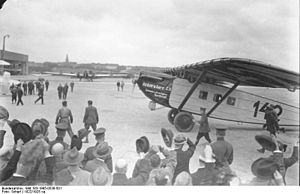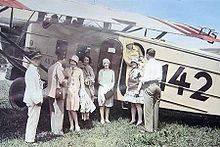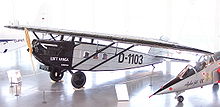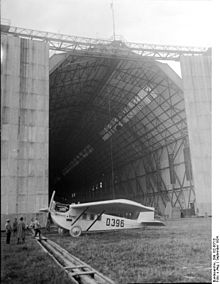- Dornier Komet
-
Komet, Merkur, and related Dornier B-Bal "Merkur" of Ad Astra Aero S.-A. Role Airliner Manufacturer Dornier Flugzeugwerke First flight 1921 The Dornier Komet, Merkur, Do D, and Do T were a family of aircraft manufactured in Germany during the 1920s, originally as small airliners, but which saw military use as well. The earliest aircraft in the series were basically landplane versions of the Delphin flying boat, and although the Delphin and Komet/Merkur series diverged from each other, design changes and refinements from one family were often incorporated into the other.
Contents
Design and development
The first Komets (Do B Komet I) utilised the wing, tail, and even upper fuselage of the early Delphin versions, but replaced the lower fuselage and sponsons with a simple sheet-metal bottom that incorporated fixed tailskid undercarriage. The engine installation was also relocated from its peculiar position above the Delphin's nose to a conventional location in the Komet's fuselage nose. Accommodation was provided for a single pilot and four passengers. An improved version, the Do B Komet II, was first flown on 9 October 1922 and was widely exported to countries including Colombia, Spain, Switzerland, and the Soviet Union.
The Do B Komet III of 1924 was a practically all-new design that shared many elements with the Delphin III. The cabin was expanded to seat another two passengers, and the wing was raised above the fuselage on short struts. This version was exported to Denmark and Sweden, but was also produced under licence in Japan by Kawasaki.
In 1925, the Komet III was replaced in production by the Do B Merkur I, which featured a revised fin and longer-span wings. When fitted with the BMW VI engine, it became known as the Do B Merkur II, as did indeed any Komets thus re-engined. The type was widely used by Deutsche Luft Hansa, which had some 30 Merkurs operating at one time, and was also exported to Brazil, China, Colombia, Japan, and Switzerland.
The Do C Komet and Do D were follow-on military designs, the former a trainer exported to Chile and Colombia, the latter a floatplane torpedo-bomber built for the Royal Yugoslav Air Force. The designation Do T was used for a landplane ambulance version.
Specifications (Merkur II)
Data from[citation needed]
General characteristics
- Crew: 2, pilot and mechanic
- Capacity: 8 passengers
- Length: 12.50 m (41 ft 1 in)
- Wingspan: 19.60 m (64 ft 4 in)
- Height: 3.56 m (11 ft 9 in)
- Wing area: 62 m2 (667 ft2)
- Empty weight: 2,100 kg (4,630 lb)
- Gross weight: 3,600 kg (7,940 lb)
- Powerplant: 1 × BMW VI, 447 kW (600 hp)
Performance
- Maximum speed: 200 km/h (124 mph)
- Service ceiling: 5,200 m (17,600 ft)
Notes
References
- Taylor, Michael J. H. (1989). Jane's Encyclopedia of Aviation. London: Studio Editions. pp. 327.
- World Aircraft Information Files. London: Bright Star Publishing. pp. File 892 Sheet 26.
External links
German aircraft between 1919-1945
Aircraft built by Zeppelin-werke Lindau(Dornier) and Dornier Flugzeugwerke Idflieg designations
1914-1919Company designations
pre-1933RLM designations
1933-1945Do 10 • Do 11 • Do 12 • Do 13 • Do 14 • Do 15 • Do 16 • Do 17 • Do 18 • Do 19 • Do 20 • Do 22 • Do 23 • Do 24 • Do 25 • Do 26 • Do 29 • Do 212 • Do 214 • Do 215 • Do 216 • Do 217 • Do 317 • Do 318 • Do 335 • Do 417 • Do 435 • Do 635
P.59 • P.85 • P.174 • P.184 • P.192 • P.231 • P.232 • P.238 • P.247 • P.252 • P.254 • P.256 • P.273 • P.1075
Company designations
post-1945Lists relating to aviation General Aircraft (manufacturers) · Aircraft engines (manufacturers) · Airlines (defunct) · Airports · Civil authorities · Museums · Registration prefixes · Rotorcraft (manufacturers) · TimelineMilitary Accidents/incidents Records Categories:- German airliners 1920–1929
- Dornier aircraft
- Single-engine aircraft
- Propeller aircraft
- High wing aircraft
Wikimedia Foundation. 2010.




